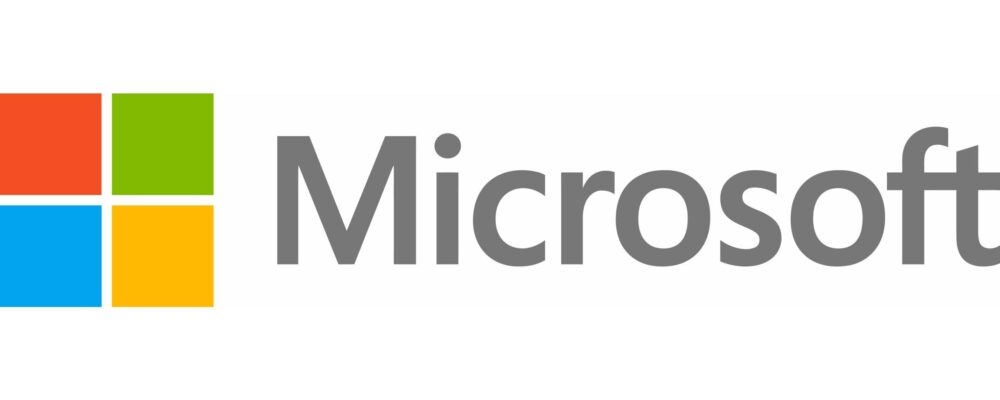It’s been a year of many advances for Microsoft Cloud for Sustainability. Now, with the expected onset of new environmental, social, and governance (ESG) reporting regulations, including those coming from the European Union’s Corporate Sustainability Reporting Directive (CSRD), we’re announcing powerful new capabilities to help organizations collect and manage more ESG data.
Microsoft Sustainability Manager, a Cloud for Sustainability solution, is being expanded to give customers fuller visibility into their environmental impact across carbon, water, and waste. And new capabilities will help customers create a comprehensive ESG data estate and prepare to meet new reporting requirements.
Read on to learn about these latest updates. You can also join Microsoft Chief Sustainability Officer Melanie Nakagawa and other sustainability leaders exploring the latest tech innovations helping companies address regulations—June 15, 2023, at 10:00 AM Pacific Time and then on demand.
Faster time to insights with Project ESG Lake (preview)
With increasing market and stakeholder pressure to adhere to new ESG reporting rules and best practices, as well as growing demand for generative AI-based experiences, organizations around the world are exploring ways to apply and analyze data in new ways. The ability to predict risk and measure and manage sustainability issues across the entire operation and value chain hinges on the ability to stitch together a complex set of disconnected data sources and services and conduct a deep analysis of sustainability, operational, and financial data.
As a result, many organizations are rethinking their data management systems and embedding sustainability more intentionally into their core business models and operations. The journey starts with organizing the data estate—from gathering, aggregating, standardizing, and analyzing data to tracing data back to the source to support audit activities.
Today we’re introducing Project ESG Lake to help organizations better manage and prepare their data for holistic analysis and ultimately advance their progress toward achieving sustainability goals.
The solution offers an expansive ESG data model with more than 400 tables covering carbon, water, waste, social, governance, biodiversity, and general business areas. Using it, organizations can build a comprehensive data estate, centralizing and transforming data from across business units and supply chains into a standard schema that’s ready for advanced analytics and reporting. Greater visibility into activities across the business will help decision-makers improve ESG and business performance while boosting long-term competitiveness.
Project ESG Lake empowers organizations to bring together ESG data from various source systems and standardize it to the ESG data model to build a centralized ESG data estate.
With this solution, organizations can:
- Bring calculated emissions data from Microsoft Sustainability Manager or other third-party solutions into their ESG data estate, leveraging data integration and transformation frameworks that are offered within Project ESG Lake.
- Integrate their Microsoft-based emissions related to their usage of Microsoft Azure and Microsoft 365 into their ESG data estate. The data can be transformed and standardized to the analytical ESG data model using Project ESG Lake’s transformation framework to prepare for analytics and reporting initiatives.
- Further enrich their data using external datasets that are offered through Project ESG Lake across various sustainability categories, including biodiversity, climate risk, energy, and ESG.
- Leverage standardized ESG data in Project ESG Lake in the new Microsoft Fabric, an end-to-end, unified analytics platform that enables developers to leverage the power of generative AI against their data and helps business users glean meaningful insights from their data. Fabric can be used to access, deploy, and compute the solutions and services offered by Project ESG Lake.
- Connect aggregated and standardized ESG data in Project ESG Lake to a set of Power BI reporting templates aligned to ESG data models. These can help organizations accelerate the analysis and reporting of ESG categories and to visualize applicable metrics in Power BI. Power BI reports and visualizations can be customized to focus on specific metrics and targets for reporting initiatives.
Enhanced ESG reporting capabilities to improve regulatory preparedness
To get ready for regulations, customers need to understand their compliance posture, track required actions, and document evidence for upcoming regulatory initiatives. They also need to shore up data governance practices to prepare for audits and reporting. To address these needs, we’re rolling out targeted features and ultimately will provide a range of prebuilt ESG reporting templates aligned to major ESG regulatory reporting standards and workflows.
CSRD template in Microsoft Purview Compliance Manager: Starting in July 2023, customers can learn what is required to be CSRD-ready according to preliminary European Sustainability Reporting Standards (ESRS). ESRS regulations are expected to be finalized in the second half of 2023. The template will help organizations begin to collect the data they need for ESRS reporting and will evolve once new standards are adopted.
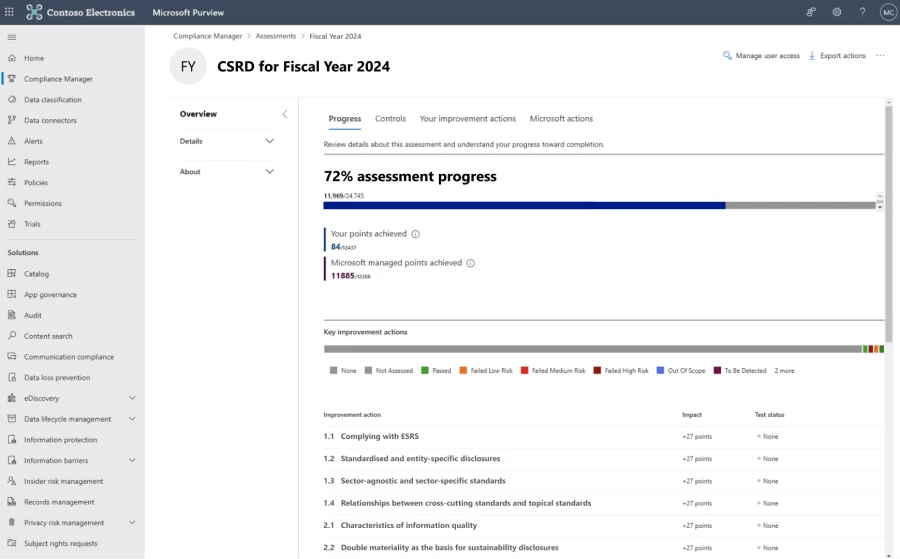
Reporting and goal alignment: Also in July 2023, organizations can use new capabilities in Microsoft Sustainability Manager to help collect quantitative emissions, water, and waste data aligned to preliminary ESRS regulations and track progress against Science Based Targets initiative (SBTi) designations.1
Comprehensive emissions data management to capture the entire carbon footprint
To ensure complete accounting of their emissions impact, organizations need to collect and manage data for all categories of emissions across their operations and supply chains. Our final round of Scope 3 emissions calculation models in Microsoft Sustainability Manager—in preview in June 2023—enables customers to store, calculate, and report all 15 Scope 3 categories. Microsoft Sustainability Manager has supported Scopes 1 and 2 since its general availability in June of 2022.
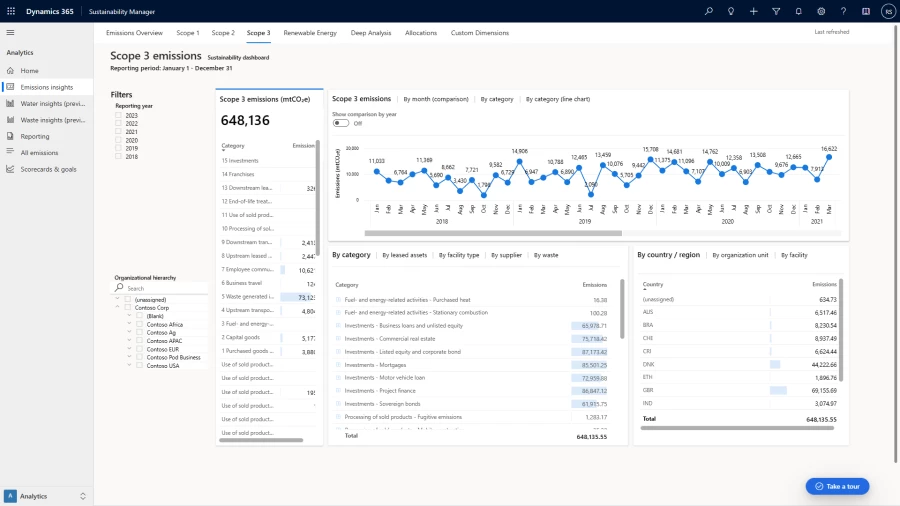
Emissions related to the processing of sold products—Scope 3 Category 10 (preview): The processing of sold products can have a significant environmental impact, particularly in industries where processing often involves energy-intensive activities like heating, cooling, and refrigeration. With Scope 3 Category 10 coverage, organizations can calculate emissions associated with this processing and identify areas where they can reduce their environmental impact and work toward more sustainable practices. These can include lowering indirect emissions generated from the processing of intermediate products sold by the reporting company but processed by third-party manufacturers before use by the end consumer.
Emissions from the use of sold products—Scope 3 Category 11 (preview): With the calculation of Scope 3 Category 11 direct and indirect emissions associated with the use of sold products, organizations can identify potential climate-related risks as well as the competitive advantages of developing low-carbon products and working with suppliers to reduce emissions.
Emissions from franchise operations—Scope 3 Category 14 (preview): Calculation of Scope 3 Category 14 emissions—including indirect emissions created by franchise operations—enables businesses to identify opportunities to improve their supply chain sustainability and reduce costs across all locations. Managing franchise emissions can help improve brand reputation, customer loyalty, and regulatory compliance while attracting and retaining franchises.
Emissions associated with investments—Scope 3 Category 15 (preview): Financial institutions mainly report emissions in Scope 3 Category 15, which refers to emissions resulting from their investments. This is an essential activity that can be quite complex as it involves gathering data from external sources and using advanced allocation methods. To facilitate this process, Microsoft Sustainability Manager provides a reliable methodology that can be directly adopted or customized to meet the specific needs of financial institutions.
Other emissions from fuel and energy—Scope 3 Category 3 (preview): Most organizations will soon need to account for fuel and energy-related emissions in their value chain—for example, coming from supplier-related activities as well as transportation and distribution losses of purchased energy. With Scope 3 Category 3 coverage, customers gain the same simple access to accounting procedures used for Scope 1 and Scope 2 fuel and energy categories but with additional considerations for value chains. Also, emissions from this category will be aligned to the appropriate scope for reporting purposes. This includes energy losses from transportation, distribution of purchased energy in Scope 2, and any other utility or fuel information not covered by Scopes 1 and 2.
Flexible greenhouse gas global warming potentials assessment (preview)
To generate more accurate calculations and help improve overall reporting and compliance, organizations can select a default greenhouse gas (GHG) global warming potentials (GWP) assessment report (inclusive of Assessment Reports 4, 5, and 6) set to use across all their calculations and still customize to a different set as needed within a calculation profile.
Waste data capabilities provide a unified view of waste sustainability data
Waste data ingestion in Microsoft Sustainability Manager (preview): Organizations have lots of waste quantity and quality data from different sources, and they need to be able to efficiently enter that data and prepare it for waste sustainability use cases. They can now link new and previously entered waste data to relevant waste categorization and disposal reference data that has been entered into Microsoft Sustainability Manager. They can also account for undigitized data sources, such as utility invoices and email or paper-based lab test reports, using waste data entry forms.
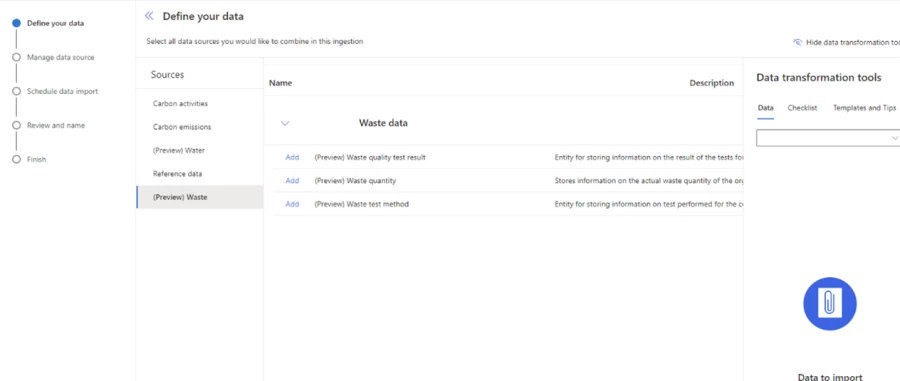
Waste quantity data visualization with Microsoft Sustainability Manager dashboards (preview): Organizations need detailed, current waste quantity data to drive accurate insights and reporting. They can now visualize up-to-date historical waste quantity data and filter, roll up, and drill down on the data at facility or organization levels, by time, waste type, and material granularity.
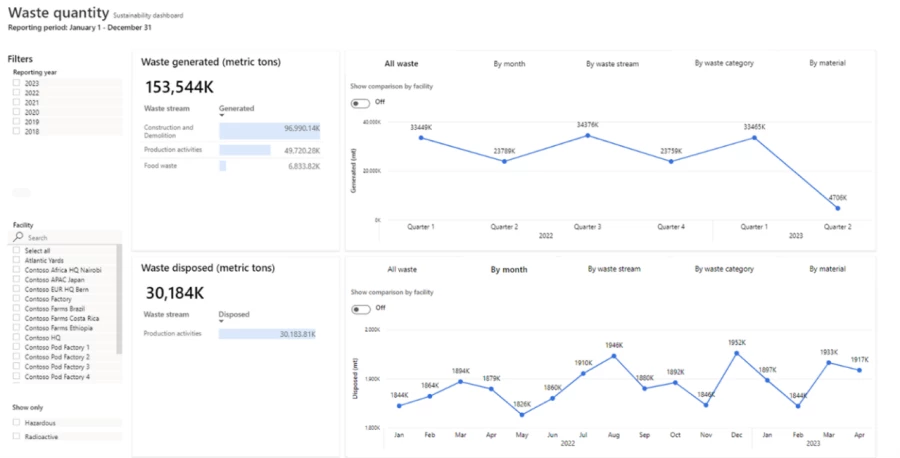
Waste sustainability disclosure using standard reports (preview): Organizations that need to drive corporate waste sustainability goals and meet external waste reporting requirements can now generate custom and regulatory waste sustainability reports in Microsoft Sustainability Manager to disclose periodic waste quantity data.
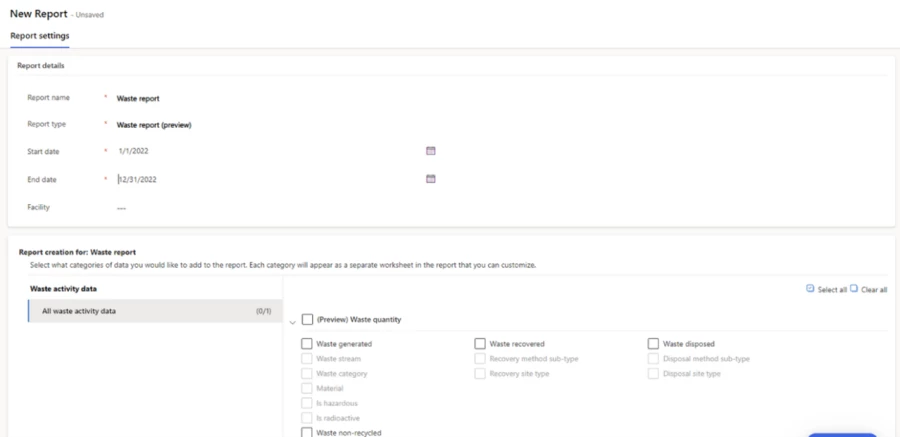
New water data capabilities helping customers accelerate water sustainability
Water revenue intensity calculation (preview): Organizations need to understand the efficiency of water usage based on overall revenue and meet external reporting requirements. Using Microsoft Sustainability Manager, they can calculate and report the total water consumed (in cubic meters) per net revenue across the organization.
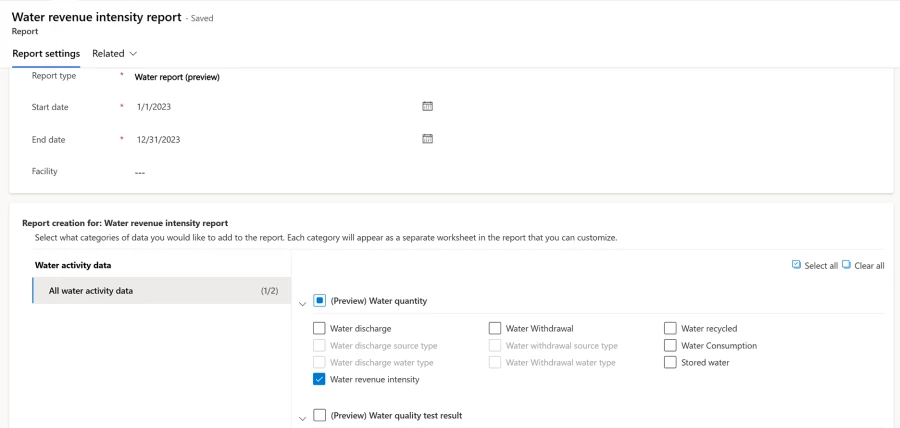
Water storage tracking (preview): Where significant quantities of inflow or outflow water are stored, organizations can report on total water stored and changes in stored water volumes to achieve compliance with external reporting requirements. In the event of negative values of water consumption, they can understand whether facilities and organizations are truly replenishing water in the ecosystem.
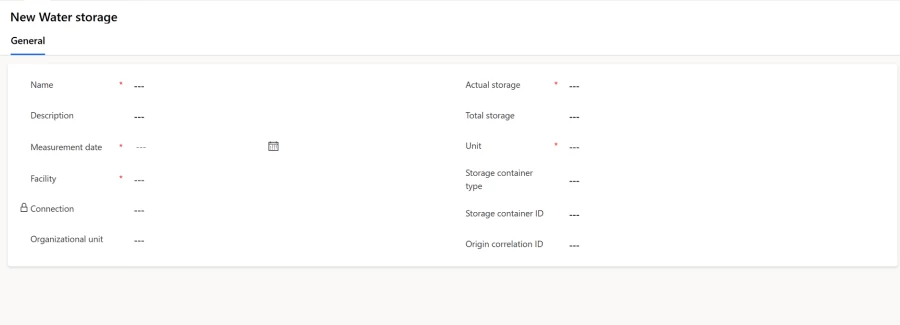
Water sustainability goal-tracking (preview): Many organizations have complex water usage scenarios challenging their ability to make progress on water sustainability goals. Microsoft Sustainability Manager helps them overcome this complexity by creating and tracking water sustainability goals from individual facilities to their entire organization.
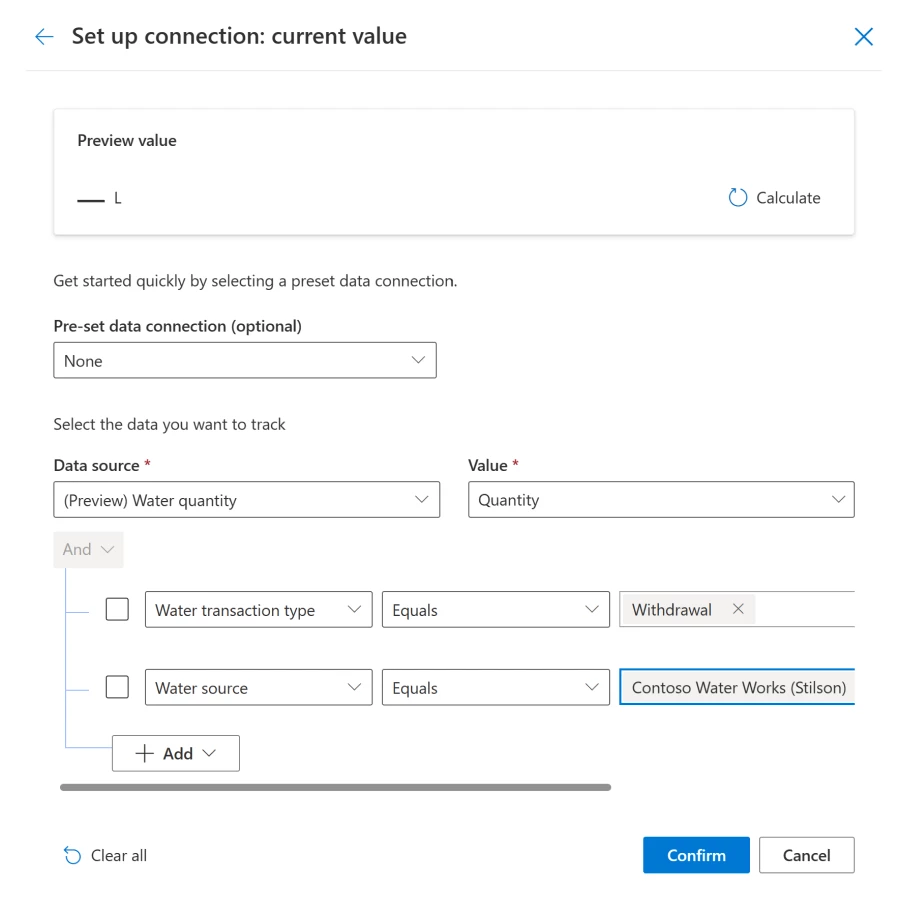
Data lake export for Microsoft 365 and Azure emissions (preview): Through the Microsoft Cloud for Sustainability API (preview) portal, customers can now export current and historic Azure and Microsoft 365 emissions directly to their Azure Data Lake Storage. They can aggregate emissions related to their Azure and Microsoft 365 usage directly in their Azure tenant to streamline analytics and reporting. This new capability also offers flexibility to connect data to other Microsoft and third-party data management and business intelligence tools.
Accelerate your sustainability progress with additional resources
Get news and updates. With regulations growing, we’re quickly innovating around ESG tracking and reporting. Sign up to receive email updates.
Deepen collaboration with the Microsoft Cloud for Sustainability community portal—coming soon. Connect and grow your knowledge as part of a vibrant customer and partner community. The new Microsoft Cloud for Sustainability portal will let you share and find answers to questions, discover valuable resources, submit product feedback—including feature requests and track updates—and join user groups and forums to talk about your areas of interest.
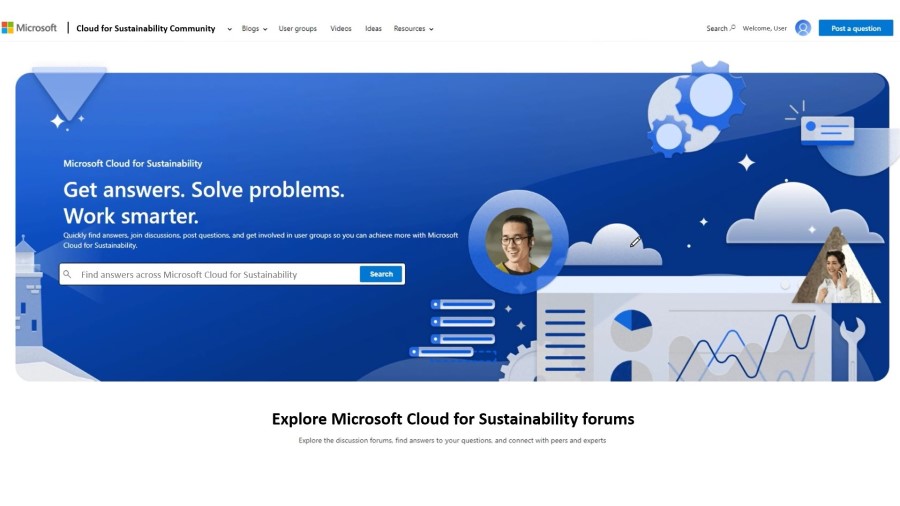
Dive deeper with the new Let’s Talk Sustainability Tech Talks—coming in July 2023. Want to know more about Microsoft industry solutions? Join expert-driven, action-oriented monthly discussions to meet the people behind the technology and get high-level concepts with live product demos. Each show will end with a knowledge review, a handful of takeaways, and recommended actions. Tech Talks will be based on real customer questions, helping you speed up your time to value while helping us refine the technology so you have a better experience. Stay tuned for details.
Microsoft is a technology company, a small local company, with few employees, no offices, and almost making no profit… >>
Please visit the firm link to site




